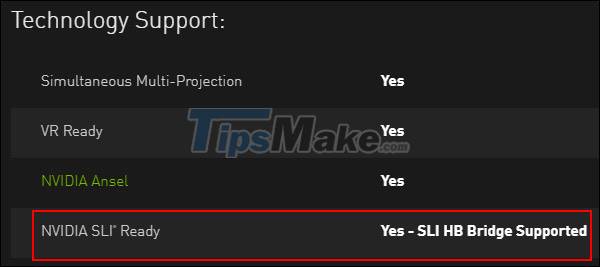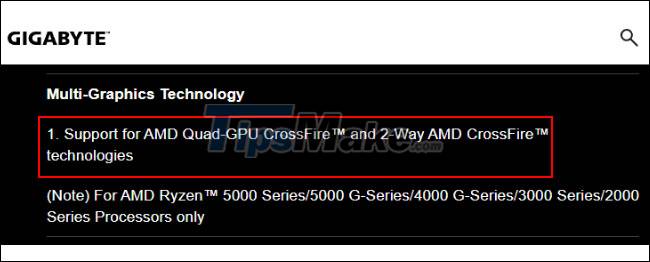Does your PC need more than one graphics card?
But the question is whether doing so is worth it and why? Find out below.
Requirements for dual GPU setup
Before getting into the story of worth or not worth, you need to dig deeper into how to implement a dual graphics card setup on a PC rig.
Basically, to run two graphics cards in a PC simultaneously, your device needs access to technologies provided by NVIDIA or AMD, designed to allow GPUs to produce the same visual output. only. They are called CrossFire (AMD) and SLI (NVIDIA). You can check if your PC is CrossFire or SLI compatible by determining if the motherboard and GPU you are using are compatible with these technologies.

Windows 11 users can press the Windows key, type Task Manager, then click the Performance tab to see information about the GPU they're using. The easiest way to see if your current graphics card supports SLI or CrossFire technology is to visit the manufacturer's website. For example, NVIDIA confirms the GeForce GTX 1070 is an 'NVIDIA SLI Ready' product and supports SLI HB Bridge.

To check if your motherboard supports SLI or CrossFire, you can look for the SLI or CrossFire markings printed on the motherboard box, or visit the manufacturer's website to see the respective specifications.

In addition to the above compatible components, you also need a computer case large enough to hold 2 graphics cards and a power supply unit (PSU) to provide enough power for the system.
Benefits of having more than one graphics card
Overall, a dual graphics card setup can give you quite a bit of benefit. The biggest advantage is nothing but a significant increase in gaming performance. Graphics rendering will now be split equally between the two GPUs instead of all in one as usual, thereby increasing frame rates and achieving higher resolutions.
To increase performance even further, the dual graphics card provides twice the amount of VRAM. For example, if you have two 4GB graphics cards, the total system VRAM will increase to 8GB. SLI-enabled games like GTA V will take full advantage of this and let you enjoy a more realistic experience, with superior frame rates and smooth graphics effects.
Also, one of the most practical advantages of a dual graphics card setup lies in the wider variety of additional display options. For example, if you're running a two-monitor setup and the single graphics card currently only supports one monitor, or supports two but only provides one HDMI output and one DisplayPort, you'll have more options with Dual graphics card setup.
Disadvantages of dual graphics card setup
Practically speaking, the biggest downside to a dual graphics card setup is the high cost. For example, a graphics card like the ASUS GeForce GTX 1050 Ti will cost close to $250. However, if you install two equivalent graphics cards, it will cost you more than $500 for this setup model.
Of course, you can opt for two low- to mid-range graphics cards, creating a really good setup for a bit less money but still getting the performance you want. However, besides the initial investment cost, another issue to consider is that the power consumption will double.
Also consider the potential cost to make sure your system can handle a dual GPU setup. If the PC components are not suitable for the dual card environment as explained above, you will have to spend more money to upgrade the hardware.
Finally, if you're using the latest hardware, it can be difficult to find a package that supports dual-card technologies. Modern graphics card models are capable of delivering high-performance gaming without multiple GPU setups. And with SLI and CrossFire support increasingly rare, game developers are favoring PCs with single graphics cards. Newer models like Gigabyte's GeForce GTX 1660 OC support one HDMI and three DisplayPort outputs, meaning you'll have a multi-monitor setup within reach for less than buying two mid-range cards.
Your choice?
Although you can completely install two graphics in one computer, it is not necessarily the most effective way to improve the graphics performance of the PC. Unless you're on a tight budget with a mid-range device that requires a multi-monitor setup for work or gaming, you might get better results upgrading your PC with a high-end graphics card.
With dual graphics card support technologies like SLI and CrossFire coming to an end, you'll also have a harder time choosing a dual graphics card setup.
You should read it
- What is a dual SIM phone?
- AMD released the dual Radeon Pro V340 GPU with 32GB HBM2 memory
- Advantages and disadvantages of dual boot (dual boot)
- Why are smatphone now using 2 SIM technology with 2 standby waves but not 2 SIMs at the same time?
- Steps to fix dual boot option not showing in Windows 10
- Should Linux dual boot?
- How to Burn Dual Layer DVD
- iPad, the next iPhone version handles graphics 4 times faster
- How to Burn Dual Layer DVDs Using Nero StartSmart
- Microsoft silently perfects dual screen support for Edge Chromium
- Dual boot (Dual boot) with virtual machine: Which one should you choose?
- How to dual-boot Raspberry Pi with BerryBoot
May be interested

5 reasons not to buy a gaming laptop

5 best laptops for 3D modeling

Is Framework Laptop the modular laptop you've been waiting for?

Review Lenovo Legion 5: Good cheap gaming laptop

Review Lenovo IdeaPad L340: The right gaming laptop for gamers on a limited budget

Asus VivoBook S15 review: A great, comprehensive experience






 List of the best graphics cards according to the price segment
List of the best graphics cards according to the price segment How to Update Graphics Card
How to Update Graphics Card Top 7 best AMD graphics cards (GPUs) 2020
Top 7 best AMD graphics cards (GPUs) 2020 7 things you need to know about integrated and dedicated graphics cards
7 things you need to know about integrated and dedicated graphics cards Use GPU-Z to analyze graphics card parameters
Use GPU-Z to analyze graphics card parameters How to fix the NVIDIA graphics card error is not displayed in Device Manager
How to fix the NVIDIA graphics card error is not displayed in Device Manager